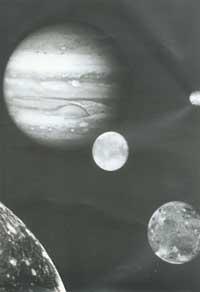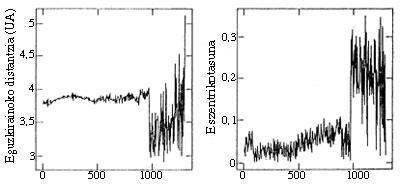Chaos in the Solar System (II)
The study of such systems did not extend until the following decade.
While chaos was considered the first article (E. Lorenz), 1963, the study of this type of systems did not extend until the next decade. This is, of course, the low level of analysis of physical examples of chaotic systems. That is why we were faced with so many unanswered problems at the end of the previous issue, when we talked about the stability of the Solar System.
This time we abandon the planets and limit ourselves to the study of the behavior of smaller bodies. These do not jeopardize the stability of the Solar System as a whole, but their behaviors may be much more striking than those described in the previous number for planets.

Saturn satellite Hyperion is one of the first to discover the case of chaos. However, by then we had already entered the 1980s, because it was found thanks to the images sent by Voyager 2. Hyperion is an irregularly looking body, its orbit is quite eccentric and it seems that both the period and axis of the spinning motion on itself change chaotically. Taking into account the dimensions of this satellite and the particularities of its orbit, it could be thought that, like the Moon, the periods of rotation and translation of Hyperion should be equal due to the decrease caused by the marital forces. That is, Hyperion should always turn Saturn with the same face.
J. Wisdom, however, discovered the completely unknown consequences when analyzing the images mentioned in Voyager. In his opinion, this satellite could go from having no turning movement to two moves around Saturn to turning with a period of ten days. Changes in the turning axis are also surprising. Not only does it reorient itself in space with the satellite, but it also changes its physical position in the latter. An important reason is needed for the Saturn system, which has been formed with the entire Solar System, to have a satellite that has not achieved stability. J. Wisdom, S. J. Peale and F. According to the hypothesis advanced by Mignard, this unstable situation is not an ancestral question, but it is because relatively little time is generated, when Hyperion falls into a chaotic field. This region of chaos is a region in which the forces acting on the satellite balance almost completely.
Balance is so precise that it is not possible to predict what the behavior of the body will be. On the other hand, the irregular shape of this satellite and the eccentricity of its orbit favor the appearance of chaos. The data sent by Voyager were scarce to determine the correction of the hypothesis proposed, and the results of other subsequent studies have not allowed a clarifying conclusion either. However, the values of the rotation periods that these studies have given, although different, do not conform at all to the translation period.
More information The same Wisdom and J. The Klaveter have studied the light curve of the satellite and consider that the chaotic behavior of Hyperion is evident.
Hyperion is not J. The only case analyzed by Wisdom. According to him, Phobos and Deimas, satellites of Mars, have also suffered long periods of chaotic evolution before reaching the current stable situation. In the first case, the chaotic period is around 20 million years, while in the case of Deimos it is five times longer. Usually, all small bodies of the Solar System would suffer chaos before stabilizing in synchronous rotation with their planets.

He also studied asteroids between the orbits of Martitz and Jupiter. As is known, bodies moving on the asteroid tape are not uniformly separated. Its orbits accumulate at certain distances from the Sun, leaving gaps between sets of orbits, the so-called Kirkwood hollows. Its reason lies in the relationship between the period of asteroids that can rotate on it and that of Jupiter. The latter would be multiple of the others. Consequently, the repetitive gravitational effect of Jupiter would generate chaos conditions by throwing asteroids from its orbit in a relatively short time.
One of the peculiarities of chaos situations is its sensitivity to initial conditions. Therefore, the bodies found on the Kirkwood stages, after falling into chaos, can end up in completely different dynamic conditions. Specifically, if they are projected they can go in different directions. Interestingly, one of Kirkwood's holes could be the source of some of the meteorites arriving on the ground. The vacuum, in particular, corresponds to the bodies whose translation period is one third of the Jupiter translation period.
G. Wetherill confirms J. This hypothesis of Wisdom. According to his studies, the drop routes of meteorites called Kondrita are compatible with the asteroid launch process proposed by Wisdom.
M. Duncan, T. Wuinn and S. The team of researchers formed by Tremain has also analyzed the dynamics of asteroids between Martitz and Jupiter in a broader work. As can be seen in the image taken from his work, the behavior of the body rotating at 3.8 astronomical units of the Sun following the circular path could become a totally chaotic behavior. For the conditions of the study body this behavior starts abruptly in about 100 million years. The image depicts the distance to the Sun and the eccentricity of the orbit.
Specifically, in the work of the three scientists mentioned there is a model of Solar System for 300 fractions. In addition to what we have just said about asteroids, it comes to significant conclusions about the bodies that could rotate between the orbits of Uranus and Neptune. About half of its movements would become chaos enough for the body to be expelled from the Solar System.

November AnniversariesSUN : 22 November enters Sagittarius at 1h 25min (UT).
PLANETS
|
Buletina
Bidali zure helbide elektronikoa eta jaso asteroko buletina zure sarrera-ontzian











